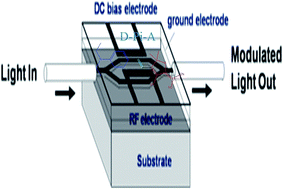Recent advances in polymer electro-optic modulators
Abstract
In this brief review, nonlinear optical (NLO) chromophores widely used in electro-optic (EO) devices are summarized according to their EO coefficients. The advances of EO modulators based on organic materials in high bandwidth and low half wave voltages (Vπ) are discussed. The review is mainly devoted to the following aspects: (1) verification of high frequency operation and reduction of Vπ for all polymer waveguide EO modulators; (2) structures and advantages of sol–gel waveguide EO modulators; (3) principles and developments of silicon–organic hybrid (SOH) EO modulators. All the considerations are illustrated by the architecture of the devices and the used physical and chemical principles are explained in detail. Further means of improvement of their parameters are indicated.


 Please wait while we load your content...
Please wait while we load your content...